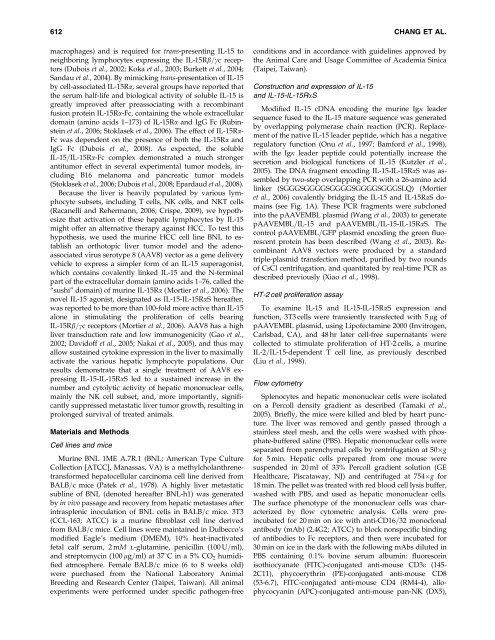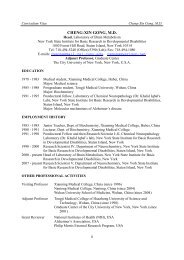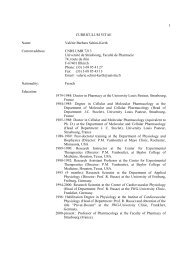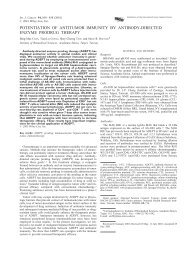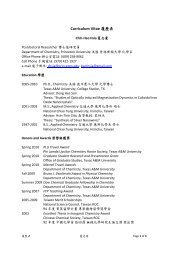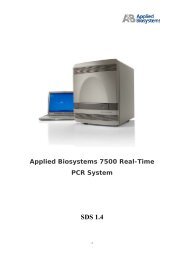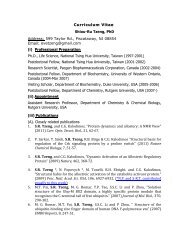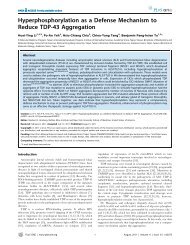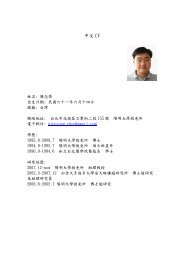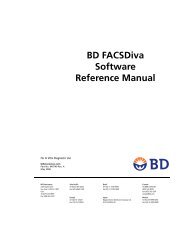View - Institute of Biomedical Sciences, Academia Sinica
View - Institute of Biomedical Sciences, Academia Sinica
View - Institute of Biomedical Sciences, Academia Sinica
- No tags were found...
You also want an ePaper? Increase the reach of your titles
YUMPU automatically turns print PDFs into web optimized ePapers that Google loves.
612 CHANG ET AL.macrophages) and is required for trans-presenting IL-15 toneighboring lymphocytes expressing the IL-15Rb=gc receptors(Dubois et al., 2002; Koka et al., 2003; Burkett et al., 2004;Sandau et al., 2004). By mimicking trans-presentation <strong>of</strong> IL-15by cell-associated IL-15Ra, several groups have reported thatthe serum half-life and biological activity <strong>of</strong> soluble IL-15 isgreatly improved after preassociating with a recombinantfusion protein IL-15Ra-Fc, containing the whole extracellulardomain (amino acids 1–173) <strong>of</strong> IL-15Ra and IgG Fc (Rubinsteinet al., 2006; Stoklasek et al., 2006). The effect <strong>of</strong> IL-15Ra-Fc was dependent on the presence <strong>of</strong> both the IL-15Ra andIgG Fc (Dubois et al., 2008). As expected, the solubleIL-15=IL-15Ra-Fc complex demonstrated a much strongerantitumor effect in several experimental tumor models, includingB16 melanoma and pancreatic tumor models(Stoklasek et al., 2006; Dubois et al., 2008; Epardaud et al., 2008).Because the liver is heavily populated by various lymphocytesubsets, including T cells, NK cells, and NKT cells(Racanelli and Rehermann, 2006; Crispe, 2009), we hypothesizethat activation <strong>of</strong> these hepatic lymphocytes by IL-15might <strong>of</strong>fer an alternative therapy against HCC. To test thishypothesis, we used the murine HCC cell line BNL to establishan orthotopic liver tumor model and the adenoassociatedvirus serotype 8 (AAV8) vector as a gene deliveryvehicle to express a simpler form <strong>of</strong> an IL-15 superagonist,which contains covalently linked IL-15 and the N-terminalpart <strong>of</strong> the extracellular domain (amino acids 1–76, called the‘‘sushi’’ domain) <strong>of</strong> murine IL-15Ra (Mortier et al., 2006). Thenovel IL-15 agonist, designated as IL-15-IL-15RaS hereafter,was reported to be more than 100-fold more active than IL-15alone in stimulating the proliferation <strong>of</strong> cells bearingIL-15Rb=gc receptors (Mortier et al., 2006). AAV8 has a highliver transduction rate and low immunogenicity (Gao et al.,2002; David<strong>of</strong>f et al., 2005; Nakai et al., 2005), and thus mayallow sustained cytokine expression in the liver to maximallyactivate the various hepatic lymphocyte populations. Ourresults demonstrate that a single treatment <strong>of</strong> AAV8 expressingIL-15-IL-15RaS led to a sustained increase in thenumber and cytolytic activity <strong>of</strong> hepatic mononuclear cells,mainly the NK cell subset, and, more importantly, significantlysuppressed metastatic liver tumor growth, resulting inprolonged survival <strong>of</strong> treated animals.Materials and MethodsCell lines and miceMurine BNL 1ME A.7R.1 (BNL; American Type CultureCollection [ATCC], Manassas, VA) is a methylcholanthrenetransformedhepatocellular carcinoma cell line derived fromBALB=c mice (Patek et al., 1978). A highly liver metastaticsubline <strong>of</strong> BNL (denoted hereafter BNL-h1) was generatedby in vivo passage and recovery from hepatic metastases afterintrasplenic inoculation <strong>of</strong> BNL cells in BALB=c mice. 3T3(CCL-163; ATCC) is a murine fibroblast cell line derivedfrom BALB=c mice. Cell lines were maintained in Dulbecco’smodified Eagle’s medium (DMEM), 10% heat-inactivatedfetal calf serum, 2 mM l-glutamine, penicillin (100 U=ml),and streptomycin (100 mg=ml) at 378C in a 5% CO 2 humidifiedatmosphere. Female BALB=c mice (6 to 8 weeks old)were purchased from the National Laboratory AnimalBreeding and Research Center (Taipei, Taiwan). All animalexperiments were performed under specific pathogen-freeconditions and in accordance with guidelines approved bythe Animal Care and Usage Committee <strong>of</strong> <strong>Academia</strong> <strong>Sinica</strong>(Taipei, Taiwan).Construction and expression <strong>of</strong> IL-15and IL-15-IL-15RaSModified IL-15 cDNA encoding the murine Igk leadersequence fused to the IL-15 mature sequence was generatedby overlapping polymerase chain reaction (PCR). Replacement<strong>of</strong> the native IL-15 leader peptide, which has a negativeregulatory function (Onu et al., 1997; Bamford et al., 1998),with the Igk leader peptide could potentially increase thesecretion and biological functions <strong>of</strong> IL-15 (Kutzler et al.,2005). The DNA fragment encoding IL-15-IL-15RaS was assembledby two-step overlapping PCR with a 26-amino acidlinker (SGGGSGGGGSGGGGSGGGGSGGGSLQ) (Mortieret al., 2006) covalently bridging the IL-15 and IL-15RaS domains(see Fig. 1A). These PCR fragments were subclonedinto the pAAVEMBL plasmid (Wang et al., 2003) to generatepAAVEMBL=IL-15 and pAAVEMBL=IL-15-IL-15RaS. Thecontrol pAAVEMBL=GFP plasmid encoding the green fluorescentprotein has been described (Wang et al., 2003). RecombinantAAV8 vectors were produced by a standardtriple-plasmid transfection method, purified by two rounds<strong>of</strong> CsCl centrifugation, and quantitated by real-time PCR asdescribed previously (Xiao et al., 1998).HT-2 cell proliferation assayTo examine IL-15 and IL-15-IL-15RaS expression andfunction, 3T3 cells were transiently transfected with 5 mg <strong>of</strong>pAAVEMBL plasmid, using Lip<strong>of</strong>ectamine 2000 (Invitrogen,Carlsbad, CA), and 48 hr later cell-free supernatants werecollected to stimulate proliferation <strong>of</strong> HT-2 cells, a murineIL-2=IL-15-dependent T cell line, as previously described(Liu et al., 1998).Flow cytometrySplenocytes and hepatic mononuclear cells were isolatedon a Percoll density gradient as described (Tamaki et al.,2005). Briefly, the mice were killed and bled by heart puncture.The liver was removed and gently passed through astainless steel mesh, and the cells were washed with phosphate-bufferedsaline (PBS). Hepatic mononuclear cells wereseparated from parenchymal cells by centrifugation at 50gfor 5 min. Hepatic cells prepared from one mouse weresuspended in 20 ml <strong>of</strong> 33% Percoll gradient solution (GEHealthcare, Piscataway, NJ) and centrifuged at 754g for18 min. The pellet was treated with red blood cell lysis buffer,washed with PBS, and used as hepatic mononuclear cells.The surface phenotype <strong>of</strong> the mononuclear cells was characterizedby flow cytometric analysis. Cells were preincubatedfor 20 min on ice with anti-CD16=32 monoclonalantibody (mAb) (2.4G2; ATCC) to block nonspecific binding<strong>of</strong> antibodies to Fc receptors, and then were incubated for30 min on ice in the dark with the following mAbs diluted inPBS containing 0.1% bovine serum albumin: fluoresceinisothiocyanate (FITC)-conjugated anti-mouse CD3e (145-2C11), phycoerythrin (PE)-conjugated anti-mouse CD8(53-6.7), FITC-conjugated anti-mouse CD4 (RM4-4), allophycocyanin(APC)-conjugated anti-mouse pan-NK (DX5),


